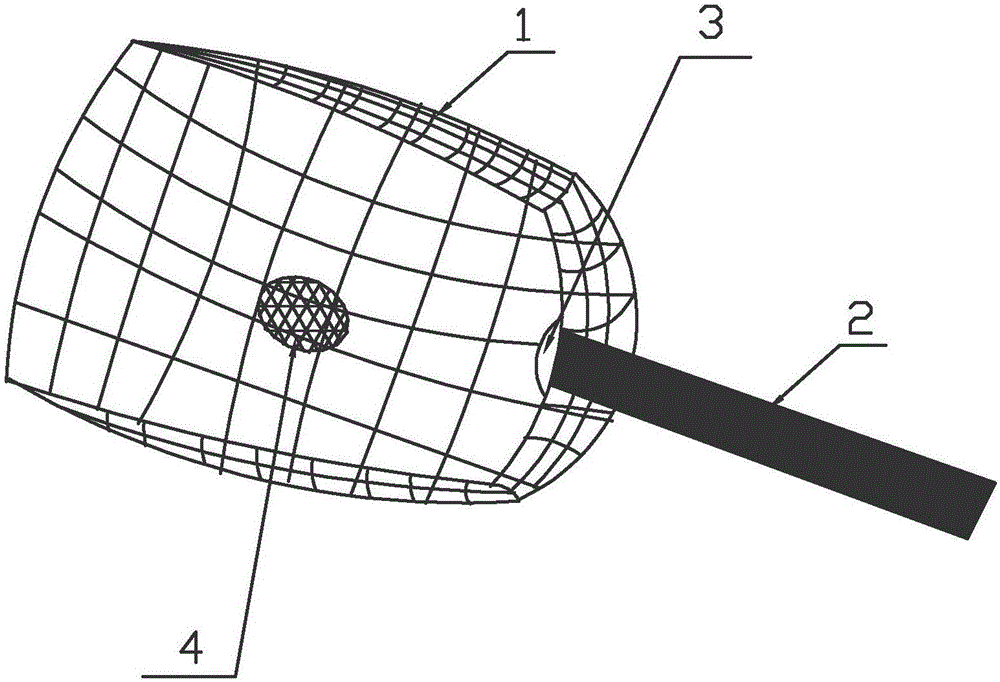A clam worm trapping apparatus and a method of trapping clam worms through the apparatus
A clam worm and trapping technology, applied in the field of clam worm harvesting, can solve the problems of time-consuming and laborious, difficult to achieve large-scale collection, high labor intensity, etc., and achieve the effects of improving collection efficiency, significant lure effect, and low labor load
- Summary
- Abstract
- Description
- Claims
- Application Information
AI Technical Summary
Problems solved by technology
Method used
Image
Examples
Embodiment 1
[0026] Such as figure 1 As shown, a lugworm trapping device includes a skip-shaped net frame 1 and a hand-held rod 2, and an LED insect trap light 3 is provided at the junction of the hand-held pole 2 and the skip-shaped net frame 1, and the LED insect trap light 3 is connected to a storage battery. The net frame is provided with an attractant net bag 4, and the lure lure is contained in the lure net bag.
[0027] The clamworm attractant is prepared from the following components in parts by weight: 45 parts of red nematodes, 38 parts of artemia, 35 parts of fish meal, 40 parts of pedicel, 28 parts of soybean meal, 25 parts of bagasse, 25 parts of cotton meal 18 parts of silkworm chrysalis, 2 parts of dry yeast powder, 1 part of myrcene, 4 parts of rosin, and 2 parts of betaine.
[0028] The preparation method of above-mentioned clamworm attractant is as follows:
[0029] (1) drying red nematodes, artemia and fish meal at 60°C, pulverizing them, passing through a 100-mesh sie...
Embodiment 2
[0035] Such as figure 1 As shown, a lugworm trapping device includes a skip-shaped net frame 1 and a hand-held rod 2, and an LED insect trap light 3 is provided at the junction of the hand-held pole 2 and the skip-shaped net frame 1, and the LED insect trap light 3 is connected to a storage battery. The net frame is provided with an attractant net bag 4, and the lure lure is contained in the lure net bag.
[0036] The clamworm attractant is prepared from the following components in parts by weight: 48 parts of red nematodes, 42 parts of artemia, 30 parts of fish meal, 36 parts of pedicel, 30 parts of soybean meal, 24 parts of bagasse, 18 parts of cotton meal 20 parts of silkworm chrysalis, 3 parts of dry yeast powder, 2 parts of myrcene, 4 parts of rosin, and 1 part of betaine.
[0037] The preparation method of above-mentioned clamworm attractant is as follows:
[0038] (1) drying red nematodes, artemia and fish meal at 60°C, pulverizing them, passing through a 100-mesh sieve...
Embodiment 3
[0044] Such as figure 1 As shown, a lugworm trapping device includes a skip-shaped net frame 1 and a hand-held rod 2, and an LED insect trap light 3 is provided at the junction of the hand-held pole 2 and the skip-shaped net frame 1, and the LED insect trap light 3 is connected to a storage battery. The net frame is provided with an attractant net bag 4, and the lure lure is contained in the lure net bag.
[0045] The clamworm attractant is prepared from the following components in parts by weight: 50 parts of red nematodes, 36 parts of artemia, 32 parts of fish meal, 35 parts of peony cauliflower, 33 parts of soybean meal, 21 parts of bagasse, 23 parts of cotton meal 15 parts of silkworm chrysalis, 3 parts of dry yeast powder, 1 part of myrcene, 5 parts of rosin, and 2 parts of betaine.
[0046] The preparation method of above-mentioned clamworm attractant is as follows:
[0047] (1) drying red nematodes, artemia and fish meal at 60°C, pulverizing them, passing through a 10...
PUM
 Login to View More
Login to View More Abstract
Description
Claims
Application Information
 Login to View More
Login to View More - R&D
- Intellectual Property
- Life Sciences
- Materials
- Tech Scout
- Unparalleled Data Quality
- Higher Quality Content
- 60% Fewer Hallucinations
Browse by: Latest US Patents, China's latest patents, Technical Efficacy Thesaurus, Application Domain, Technology Topic, Popular Technical Reports.
© 2025 PatSnap. All rights reserved.Legal|Privacy policy|Modern Slavery Act Transparency Statement|Sitemap|About US| Contact US: help@patsnap.com

